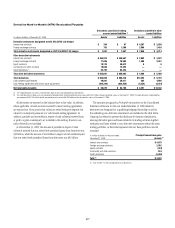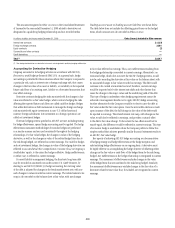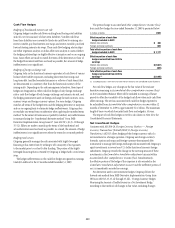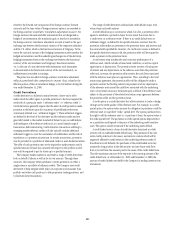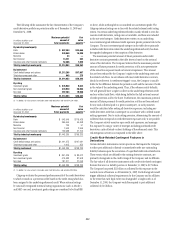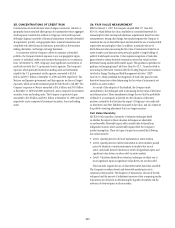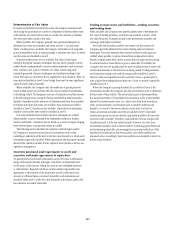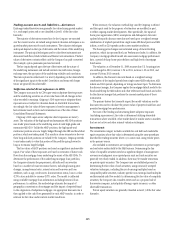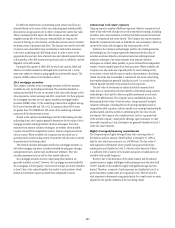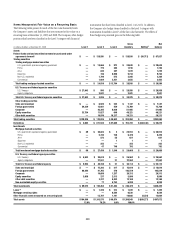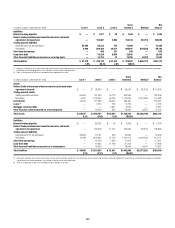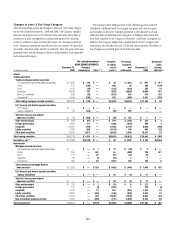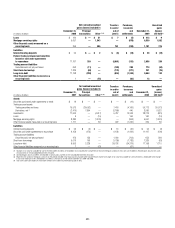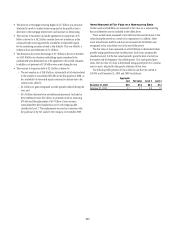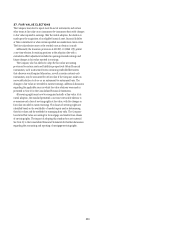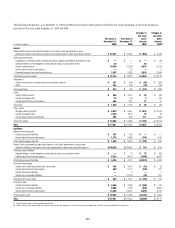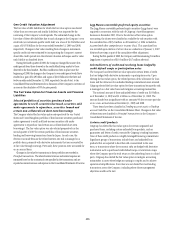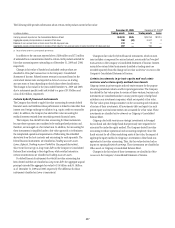Citibank 2009 Annual Report Download - page 237
Download and view the complete annual report
Please find page 237 of the 2009 Citibank annual report below. You can navigate through the pages in the report by either clicking on the pages listed below, or by using the keyword search tool below to find specific information within the annual report.227
For ARS with student loans as underlying assets, future cash flows are
estimated based on the terms of the loans underlying each individual ARS,
discounted at an appropriate rate in order to estimate the current fair value.
The key assumptions that impact the ARS valuations are the expected
weighted average life of the structure, estimated fail rate coupons, the
amount of leverage in each structure and the discount rate used to calculate
the present value of projected cash flows. The discount rate used for each ARS
is based on rates observed for basic securitizations with similar maturities
to the loans underlying each ARS being valued. In order to arrive at the
appropriate discount rate, these observed rates were adjusted upward to factor
in the specifics of the ARS structure being valued, such as callability, and the
illiquidity in the ARS market.
During the first quarter of 2008, ARS for which the auctions failed and
where no secondary market has developed were moved to Level 3, as the
assets were subject to valuation using significant unobservable inputs. The
majority of ARS continue to be classified as Level 3.
Alt-A mortgage securities
The Company classifies its Alt-A mortgage securities as held-to-maturity,
available-for-sale, and trading investments. The securities classified as
trading and available-for-sale are recorded at fair value with changes in fair
value reported in current earnings and AOCI, respectively. For these purposes,
Alt-A mortgage securities are non-agency residential mortgage-backed
securities (RMBS) where (1) the underlying collateral has weighted average
FICO scores between 680 and 720 or (2) for instances where FICO scores
are greater than 720, RMBS have 30% or less of the underlying collateral
composed of full documentation loans.
Similar to the valuation methodologies used for other trading securities
and trading loans, the Company generally determines the fair value of Alt-A
mortgage securities utilizing internal valuation techniques. Fair-value
estimates from internal valuation techniques are verified, where possible,
to prices obtained from independent vendors. Vendors compile prices from
various sources. Where available, the Company may also make use of
quoted prices for recent trading activity in securities with the same or similar
characteristics to that being valued.
The internal valuation techniques used for Alt-A mortgage securities, as
with other mortgage exposures, consider estimated housing price changes,
unemployment rates, interest rates and borrower attributes. They also
consider prepayment rates as well as other market indicators.
Alt-A mortgage securities that are valued using these methods are
generally classified as Level 2. However, Alt-A mortgage securities backed by
Alt-A mortgages of lower quality or more recent vintages are mostly classified
as Level 3 due to the reduced liquidity that exists for such positions, which
reduces the reliability of prices available from independent sources.
Commercial real estate exposure
Citigroup reports a number of different exposures linked to commercial real
estate at fair value with changes in fair value reported in earnings, including
securities, loans and investments in entities that hold commercial real estate
loans or commercial real estate directly. The Company also reports securities
backed by commercial real estate as Available-for-sale investments, which are
carried at fair value with changes in fair-value reported in AOCI.
Similar to the valuation methodologies used for other trading securities
and trading loans, the Company generally determines the fair value of
securities and loans linked to commercial real estate utilizing internal
valuation techniques. Fair-value estimates from internal valuation
techniques are verified, where possible, to prices obtained from independent
vendors. Vendors compile prices from various sources. Where available, the
Company may also make use of quoted prices for recent trading activity
in securities or loans with the same or similar characteristics to that being
valued. Securities and loans linked to commercial real estate valued using
these methodologies are generally classified as Level 3 as a result of the
reduced liquidity currently in the market for such exposures.
The fair value of investments in entities that hold commercial real
estate loans or commercial real estate directly is determined using a similar
methodology to that used for other non-public investments in real estate
held by the S&B business. The Company uses an established process for
determining the fair value of such securities, using commonly accepted
valuation techniques, including the use of earnings multiples based on
comparable public securities, industry-specific non-earnings-based multiples
and discounted cash flow models. In determining the fair value of such
investments, the Company also considers events, such as a proposed sale
of the investee company, initial public offerings, equity issuances, or other
observable transactions. Such investments are generally classified as Level 3
of the fair-value hierarchy.
Highly leveraged financing commitments
The Company reports highly leveraged loans with a carrying value of
$36 million and face amount of $468 million at December 31, 2009 as
held-for-sale, which are measured on a LOCOM basis. The fair value of
such exposures is determined, where possible, using quoted secondary-
market prices and classified as Level 2 of the fair value hierarchy if there
is a sufficient level of activity in the market and quotes or traded prices are
available with suitable frequency.
However, due to the dislocation of the credit markets and the reduced
market interest in higher risk/higher yield instruments since the latter half
of 2007, liquidity in the market for highly leveraged financings has been
limited. Therefore, a majority of such exposures are classified as Level 3 as
quoted secondary market prices do not generally exist. The fair value for
such exposures is determined using quoted prices for a similar asset or assets,
adjusted for the specific attributes of the loan being valued.


